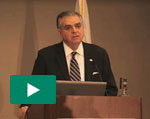Solutions for Distracted Driving
By Bob Shepard
 |
A few weeks ago, a woman in upstate New York died when her car collided with a tractor-trailer. Not long before, a Texas teen was killed when her station wagon ran into another truck. Each driver was under the influence—not of alcohol, but of the glowing screens of their cell phones. Both women were texting while driving when the crashes occurred.
Those chilling tales were part of the keynote address given by United States Secretary of Transportation Ray LaHood at the Alabama Distracted Driving Summit in Birmingham in early December. The summit was the first statewide response to LaHood’s call for a national debate on distracted driving—a practice he paints with the same brush as drunk driving.
“Distracted driving is appropriately described as an epidemic in this country,” says Despina Stavrinos, Ph.D., a researcher at the UAB University Transportation Center (UAB UTC), who along with Russ Fine, Ph.D., director of the UAB UTC and its parent, the UAB Injury Control Research Center and others organized the Alabama summit. The University Transportation Center for Alabama (UTCA), based out of the University of Alabama co-sponsored the event.
Appetite for Distraction
“The U.S. Department of Transportation estimates that 800,000 vehicles were driven by someone using a cell phone in 2008, 6,000 people died in distracted driving-related vehicle crashes, and 500,000 were injured,” Stavrinos says. A report released on January 12, 2010, from the National Safety Council reported that 28 percent of traffic accidents are caused by people talking on cell phones or sending text messages.
Distracted driving is anything that takes a person’s attention away from the safe operation of their vehicle, Stavrinos explains. Eating, drinking, applying makeup, and tuning the radio used to be the prime culprits. But these days, cell phones, digital music players, and Blackberries have fueled a marked increase in a problem that shows little signs of abating on its own.
“Texting, tweeting, surfing the Internet, or even just talking on a cell phone provide multiple distractions,” says Stavrinos. “You tend to take your eyes off the road, your hands off the wheel, and your mind off of what you are supposed to be doing—driving safely.”
The danger is highest for young drivers, who have grown up surrounded by handheld electronic technology. According to surveys conducted by the Pew Research Center, 70 percent of 16- and 17-year-olds admit they’ve been in a car while the driver was texting.
“I’ve been driving for more than 20 years and only recently began to text, so I certainly recognize texting as a distraction,” said Richard Hanowski, Ph.D., director of the Center for Truck and Bus Safety at the Virginia Tech Transportation Institute, in remarks at the Alabama summit. “But for most teens, they’ve been texting or using handheld electronics since they were 9 or 10 years old, and are only now getting behind the wheel of a car. For them, it’s the driving that’s a distraction!”
New Rules of the Road
In search of solutions, the Alabama Distracted Driving Summit brought together leaders in transportation, public policy, law enforcement, and science to discuss ways to change behavior through legislation, enforcement, public awareness, and education.
In his remarks, Secretary LaHood said that the same tactics that have curbed drunk drivers should be applied to distracted motorists. “Decades of experience with drunk driving has taught us it takes a consistent combination of education, effective enforcement, a committed judiciary, and collective efforts by local, state, and national advocates to put a dent in the problem.”
LaHood outlined steps that he hopes will become part of the nation’s collective driving routine: Parents need to set clear ground rules for teenage drivers and enforce them. Teens need to exert peer pressure and tell friends they won’t ride with them if they text. Employers need to let employees travel to destinations without interruption. And everybody needs to use some common sense every time they get behind the wheel.
Forty-six states have legislation pending banning distracted driving in one form or another, and LaHood says the insurance and telecommunications industries are actively engaged in the struggle to curb dangerous driving behavior.
Distracted Driving Theater
UAB’s UTC is helping make a major push for bi-partisan legislative action in Alabama. Stavrinos says the summit identified a number of promising avenues, some of which are already in the planning stages. The state has assigned responsibility for addressing the issue of distracted driving to the Alabama Department of Economic and Community Affairs and the State Safety Coordinating Committee, which has developed an Alabama Strategic Highway Safety Plan.
“Because of the summit, many more people in the private sector and in government have become better informed about the distracted-driving problem,” says Fine. “Our goal now is to continue to increase awareness among policy- and decision-makers on both sides of the aisle as well as the general public.”
Fine says the UAB UTC will provide each member of the Alabama Legislature with a DVD copy of presentations made at the summit. The center also plans to set up a Distracted Driving Theater in the capitol in Montgomery, where legislators, their staffs, civil service employees, and members of the general public will be able to view DVD copies of all presentations and panel discussions made during the summit. Other anti-distracted driving information also will be distributed through the theater.
“We intend to keep the anti-distracted driving campaign going throughout the entire regular 2010 session of the Alabama Legislature, or until an anti-distracted driving bill is signed into law by the governor, whichever occurs first,” says Fine.
More Information
The U.S. Department of Transportation has launched a site to help combat the problem: www.distraction.gov.
